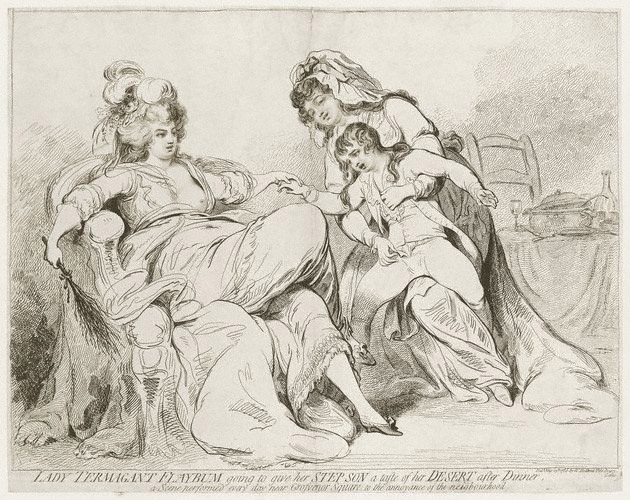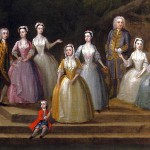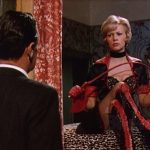Gatrell, Vic. City of Laughter: Sex and Satire in Eighteenth-Century London Walker & Company, 2006 Pg. 331-44
The fill title of the above print, published by William Holland’s shop in 1786 by James Gillray (at the time an up-and-comer in his field), is Lady Termagant Flaybum Going to Give her Step Son a Taste of her Desert after Dinner, A Scene Performed Every Day near Grosvenor Square, to the Annoyance of the Neighbourhood. For a print commissioned as a particularly nasty bit of character assassination and slander, it’s a very well-done work. The faces are uncaricatured and finely detailed.
As Gatrell puts it, “The print carried its own pornographic shadow.” William Holland shared shop space with a publisher of flagellation literature, George Peacock. Peacock published works like Sublime of Flagellation: or Letters from Lady Termagant Flaybum to Lady Harriet Tickletail, of Bumfiddle Hall (c.1777-85) and Exhibition of Female Flagellants in the Modest and Incontinent World (1777). The latter claimed that women engaged in the pleasures of flagellation of their own and others’ children, as much as men. (I.e. projecting fantasies of sadism onto women.) Flagellation themes frequently appeared in Gillray’s work.
The “Lady Termagant Flaybum” name was already known, at least among the wealthier men who could afford such prints, before it was attached to Mary Eleanor Bowes (1749-1800). Born to great wealth and raised to be an educated and freethinking (and somewhat irreligious) woman, Bowes (later Lady Strathmore) was the partial basis for Thackeray’s novel Bary Lyndon. Her main character flaw was rotten taste in men (or maybe the pickings were just slim.) In 1777, she fell for and married all-around scoundrel Andrew Robinson Stoney, “the libertine adventurer incarnate,” as Gatrell puts it.
Stoney managed to get control of Bowes’ estates and used it fund his profligacy, while verbally and physically abusing her. (This came out in the divorce trial a decade later.) He coerced her into writing her own Confessions, a quasi-pornographic work detailing her own flirtations and adulteries, her attempt to get an abortion and her irreligion. When Bowes finally had enough, separated from him and started legal proceedings, his abuse shaded into revenge, stalking her and attacking her character.
Gatrell describes commissioning the Lady Flaybum print as “a resort to image magic against his wife in a culture highly respectful of the image’s power.” Gillray may have been incoherently instructed, as Bowes allegedly had an “unnatural dislike” of her eldest son (not her step-son), and there’s no evidnce she had anything to do with flagellation other than Stoney’s claims. Other Gillray prints picked up on Bowes’ supposed preference to cats over her own children by depicting her nursing cats at her breasts while her son cries, not to mention drinking with and sleeping with servants.
A few months after the publication of the Flaybum print, Stoney actually kidnpapped Bowes with the help of armed thugs and a bribed constable, and fled into the wilds with her, pursued by constables and angry locals. (Life was imitating a Gothic novel.) At last, she was freed and Bowes was stopped in a country field. She went back to London.
The legal battles continued while Stoney was in prison, with Stoney using his wife’s extorted Confessions against her. They were openly published in 1793.
You could see this sordid affair as a collision between the old idea of libertinism and the idea of equal desire between the sexes, and the nascent cult of motherhood that would come to full fruition in the Victorian era. Bowes was as much of a female libertine as it was realistically possible to be, and Stoney’s principal attack on her character was that she was an abusive mother. She had no character to salvage, no way to turn public opinion to her side.
The two semi-pornographic works Stoney commissioned (so to speak) were used to control and to damage his wife via her public reputation (and sad to say, few people cared much about her situation.) What interests me is that these works may have been read as pornography by people who didn’t know or care about the real person they refer to. Furthermore, these images and texts may have hung around and been read by people long after Stoney and Bowes faded from public knowledge or been relevant. I can imagine people in later generations seeing the Flaybum print as inspiration for masochistic erotic fantasy. The two women in the print are depicted as beautiful, not grotesque caricatures as common in such prints.
Gillray was an interesting artist of this period. Whereas Rowlandson was erotic but light and fluffy and never without a humorous or satiric point, Gillray tended towards the blunt and the direct. The rule in high art was to show the moment before violence, but Gillray showed the event itself or its immediately and bloody aftermath. This is not to say that Gillray couldn’t be subtle and witty when he wanted, even about sexual matters.

As another example of fetishistic or perverse (mis)reading, this image could be also read as fodder for foot fetish fantasies.




